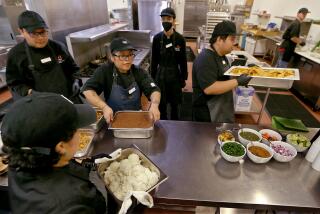Molecules in the microwave are “having a real wild party and carrying on, right?”
- Share via
The demands of cooking in the modern kitchen may not call as much upon inspiration and training as in pre-electronic times, but there is a certain intellectual discipline implied in the use of such sophisticated wares as the microwave oven.
Jill Wylly, a North Hollywood teaching assistant who is working on her credential in home economics, thinks the principles of cooking in microwave ovens can be taught at an early age, and should be, since children, naturally, get their hands on them.
So Wylly organized a new class under the Pierce College community services department to teach the principles of microwave cooking to children 8 to 11 years old.
Three boys and six girls were delivered by their mothers for Wylly’s first class Monday at Friedman’s Microwave Ovens on Ventura Boulevard in Encino.
The students assembled at the back of the store on metal chairs, facing a kitchen counter with a microwave oven at each end and a mirror angled above to give them a view of the countertop.
“You all have microwave ovens at home, right?” she asked. They did.
“Does everybody know how to start their microwave oven?” They did.
She asked what they had cooked.
“Hot dogs,” said one. “Rice Krispies,” said another.
“Barf,” said a boy named Matt, who wore blue gym shorts and a No. 86 jersey.
To begin, Wylly explained the theory of microwave energy, using the metaphor of children at play to suggest the molecules of food inside the microwave.
“If you were to look in a microscope at your food cooking, you’d see all of these little bubbles dancing all over the place, and they’re just having a grand old time, and they’re bouncing all over, and they’re having a real wild party and carrying on, right?” she said.
“That creates heat, and that is the heat which is doing the cooking so we don’t have a hot kitchen, which is nice, and food cooks faster, which is real nice. Also, that’s why we can use paper plates and plastic wrap and waxed paper, and they don’t catch on fire. Any questions?”
Matt had a question.
“Can I help make the pudding?”
It wasn’t time for that yet. Wylly first cooked slices of bacon using three paper plates so the grease wouldn’t soak through.
To demonstrate the microwave principle of “standing,” she cooked a potato for five minutes. It was hard when she took it out, but it softened while standing. She explained that, like children, molecules have a hard time slowing down just because Mommy turned out the lights.
Wylly showed how to slice hot dogs so they wouldn’t explode. Then the children ate them.
Matt volunteered to mix a pound of hamburger for meat loaf. He squished the meat through his fingers.
“I’m going to barf in a few seconds,” he said, studying his work.
Sending Matt back to his chair, Wylly used a spoon to shape the raw meat into an “O” on a paper plate.
She called that the principle of “arrangement” and explained that microwaves don’t do as much cooking in the middle as on the outside.
For the third principle, called “stirring,” she had a girl named Amy cook another pound of hamburger in a dish for two minutes.
Under the mirror she showed that it was still raw in the center but a runny brown color on the edges.
“Oh, sick,” a girl said.
Wylly stirred it and put it back in the oven for two minutes, then said it was time for pudding.
“Please. Pretty please,” Matt said, jumping up and down.
Wylly snubbed him for another boy who had raised his hand quietly.
While the pudding was cooking, Wylly started adding things to the hamburger for chili.
“Do you have to put beans?” a boy named Seth said. “I hate beans.”
“Tomato, yuk,” a girl groaned.
While the chili cooked, they ate the meat loaf on napkins.
Matt put his piece on his chair and sat on the floor. He had seconds and thirds.
“You’ve got chili coming up, so don’t get too filled up on meat loaf,” Wylly urged.
No one wanted chili, though. One girl even crouched down behind a chair.
“Well, next children’s class, we don’t do chili,” Wylly said.
When it finally came time to make pudding pie, all the children stood at the counter to watch Wylly pour pudding over vanilla wafers that a slightly built girl named Melanie laid out in a glass pie dish.
The pie then went into the refrigerator. Several girls helped Wylly make pizzas on English muffins and cinnamon pinwheels using bread, cream cheese, butter, sugar and cinnamon.
Wylly’s final demonstration was cooking a paper plate full of cauliflower, broccoli and mushrooms, arranged in circles, according to their tenderness.
“OK. Questions?” she asked.
“Pudding! Pudding!” the children cried. But she insisted on a review.
“What’s something we have to do with hot dogs and potatoes before we put them in a microwave oven?” she asked.
“Stab them,” the quiet boy said.
By then, the mommies were coming back.
Seth’s mother was in a hurry. She made him take his pudding pie to the car.
Melanie’s mother was concerned that she didn’t get enough for lunch.
“What is that other stuff that you missed?” she said, pointing to the cinnamon pinwheels. “Why don’t you go get some before they’re all gone?”
Melanie ate a cinnamon pinwheel.
More to Read
Eat your way across L.A.
Get our weekly Tasting Notes newsletter for reviews, news and more.
You may occasionally receive promotional content from the Los Angeles Times.










